Birth to Age Three
Our Birth-to-Three Program offers families a combination of off- and on-site therapy options to best meet individual child and family needs. Regardless of their location, family-infant therapy sessions focus on the development of communication skills in a caring and supportive environment. Through guided interactions, families learn how to connect with and nurture their child as well as learning strategies for helping their child to develop spoken language.
Off-site therapy sessions occur in your child’s natural environment, where the child and family are most comfortable. That may be in the child’s home, daycare, community-based setting, or the home of an extended family member. Off-site therapy sessions promote successful communication across a variety of settings, effectively carrying over therapy strategies and activities into your child’s daily life. They also promote family involvement by including a variety of your child’s significant communication partners.
Tele-therapy is another option for our birth to three families. Tele-therapy utilizes video conferencing technology to connect early intervention therapists to families in their natural environments. Care-givers take an active role in choosing therapy settings and activities while therapists provide coaching, feedback and suggestions to maximize listening and spoken language practice within the context of the child and family’s daily activities. We have seen excellent outcomes using tele-therapy coaching during our birth to three sessions.
Both individual and group on-site therapy sessions take place at the ECHO Building and provide a number of different benefits from off-site services.
Individual onsite therapy sessions limit auditory and visual distractions and maximize the signal-to-noise ratio so these young children who are just learning to listen with their hearing devices can establish an auditory based language system. Additionally, therapists can collaborate with ECHO audiologists to provide support for hearing testing, ensure that hearing technology is fit appropriately, and when necessary, share feedback regarding changes to hearing technology.
On-site play groups promote communication development and social growth through language-rich, theme-based activities. Playgroup allows children to make connections with other children who are deaf and hard of hearing through exploration and play. Playgroup also provide opportunities for families of children who are deaf and hard of hearing to interact with other parents who are at a similar point in their journey to develop spoken language through listening, providing a support group of sorts.
Parents also have the opportunity to step away from playgroup periodically to attend parent panels and education sessions while their children continue to play and learn in the group. Families find inspiration, hope and encouragement through these interactions with other parents who have already navigated the paths they are just discovering. Another highlight of attending on-site playgroup is the opportunity to interact with older children who are deaf and hard of hearing who have established hearing device use and communication skills.
SHARE INFORMATION ABOUT YOUR CHILD
